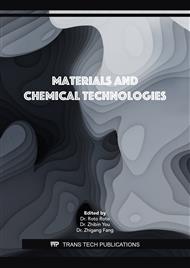[1]
C. Gupta, G. Sharma, D. Chan, Resveratrol: A Chemo-preventative Agent with Diverse Applications, in D. Prakash, G. Sharma (Eds.), Phytochemicals of Nutraceutical Importance, CABI, Wallingford, UK, 2014, p.47–60.
DOI: 10.1079/9781780643632.0047
Google Scholar
[2]
F. Derradji-Benmeziane, R. Djamai, Y. Cadot, Antioxidant capacity, total phenolic, carotenoid, and vitamin C contents of five table grape varieties from Algeria and their correlation, OENO One 48 (2014) 153–162.
DOI: 10.20870/oeno-one.2014.48.2.1564
Google Scholar
[3]
M. Lubis, A. Gana, S. Maysarah, M.H.S. Ginting, M.B. Harahap, Production of bioplastic from jackfruit seed starch (Artocarpus heterophyllus) reinforced with microcrystalline cellulose from cocoa pod husk (Theobroma cocoa L) using glycerol as plasticizer, IOP Conf. Ser.: Mater. Sci. Eng. 309 (2018) 012100.
DOI: 10.1088/1757-899x/309/1/012100
Google Scholar
[4]
B. Santosa, W. Wirawan, Chemistry changes in minimally process snake fruit variety pondoh during storage in room temperature which coating used edible coating from starch of jackfruit seed, IEESE Int. J. Sci. Technol. 3 (2014) 15–18.
Google Scholar
[5]
K. Kairyte, A. Kadys, Z. Luksiene, Antibacterial and antifungal activity of photoactivated ZnO nanoparticles in suspension, J. Photochem. Photobiol., B 128 (2013) 78–84.
DOI: 10.1016/j.jphotobiol.2013.07.017
Google Scholar
[6]
A.M. Youssef, S.M. El-Sayed, Bionanocomposites materials for food packaging applications: Concepts and future outlook, Carbohydr. Polym. 193 (2018) 19–27.
DOI: 10.1016/j.carbpol.2018.03.088
Google Scholar
[7]
B.J. Arroyo, A.C., Bezerra, L.L. Oliveira, E.A. de Melo, A.M.P. Santos, Antimicrobial active edible coating of alginate and chitosan add ZnO nanoparticles applied in guavas (Psidium guajava L.), Food Chem. 309 (2020) 125566.
DOI: 10.1016/j.foodchem.2019.125566
Google Scholar
[8]
V.G.L. Souza, C. Rodrigues, S. Valente, C. Pimenta, J.R.A. Pires, M.M. Alves, C.F. Santos, I.M. Coelhoso, A.L. Fernando, Eco-friendly ZnO/chitosan bionanocomposites film for packaging of fresh poultry meat, Coatings 10 (2020) 110.
DOI: 10.3390/coatings10020110
Google Scholar
[9]
W.E. Sause, P.T. Buckley, W.R. Strohl, A.S. Lynch, V.J. Torres, Antibody-based biologics and their promise to combat Staphylococcus aureus infections, Trends Pharmacol. Sci. 37 (2016) 231–241.
DOI: 10.1016/j.tips.2015.11.008
Google Scholar
[10]
D.A. Skoog, F.J. Holler, T.A. Neiman, Principles of Instrumental Analysis, Saunders College Publishing, New York, (1998).
Google Scholar
[11]
Y. Wang, J. Li, R. Hong, Large scale synthesis of ZnO nanoparticle via homogenous precipitation, J. Cent. South Univ. 19 (2012) 863–868.
DOI: 10.1007/s11771-012-1084-4
Google Scholar
[12]
S. Bai, J. Hu, D. Li, R. Luo, A. Chen, C.C. Liu, Quantum-sized ZnO nanoparticles: Syntesis, characterization and sensing properties for NO2, J. Mater. Chem. 21 (2011) 12288–122294.
DOI: 10.1039/c1jm11302j
Google Scholar
[13]
K. Nisah, M.B. Yati, Efek edible coating pada kualitas alpukat (Persea America Mill) selama penyimpanan, AMINA 1 (2019) 11–17.
DOI: 10.22373/amina.v1i1.9
Google Scholar
[14]
M. Mukama, A. Ambaw, T.M. Berry, U.L. Opara, Analysing the dynamics of quality loss during precooling and ambient storage of pomegranate fruit, J. Food Eng. 245 (2019) 166–173.
DOI: 10.1016/j.jfoodeng.2018.10.020
Google Scholar
[15]
F. Salehi, Edible coating of fruits and vegetables using natural gums: A review, Int. J. Fruit Sci. 20 (2020) S570–S589.
DOI: 10.1080/15538362.2020.1746730
Google Scholar



